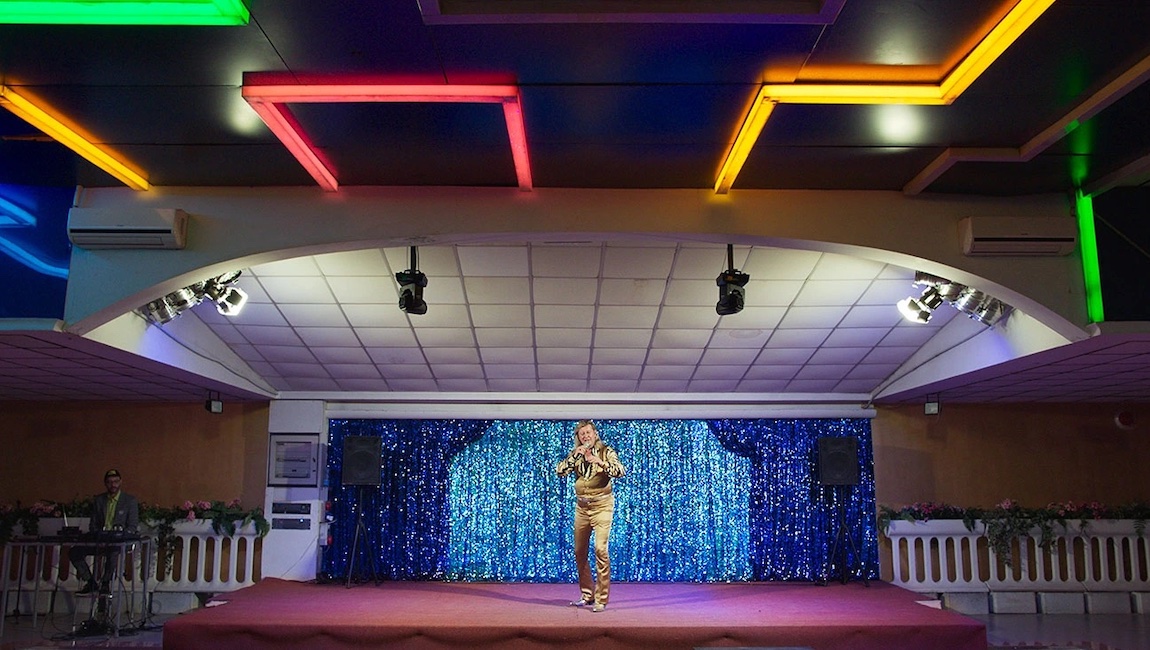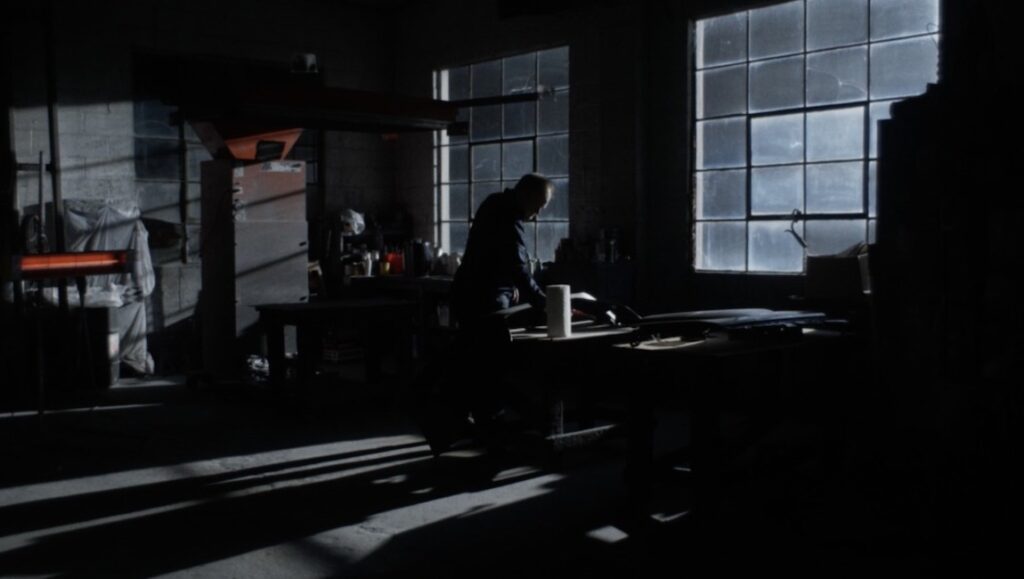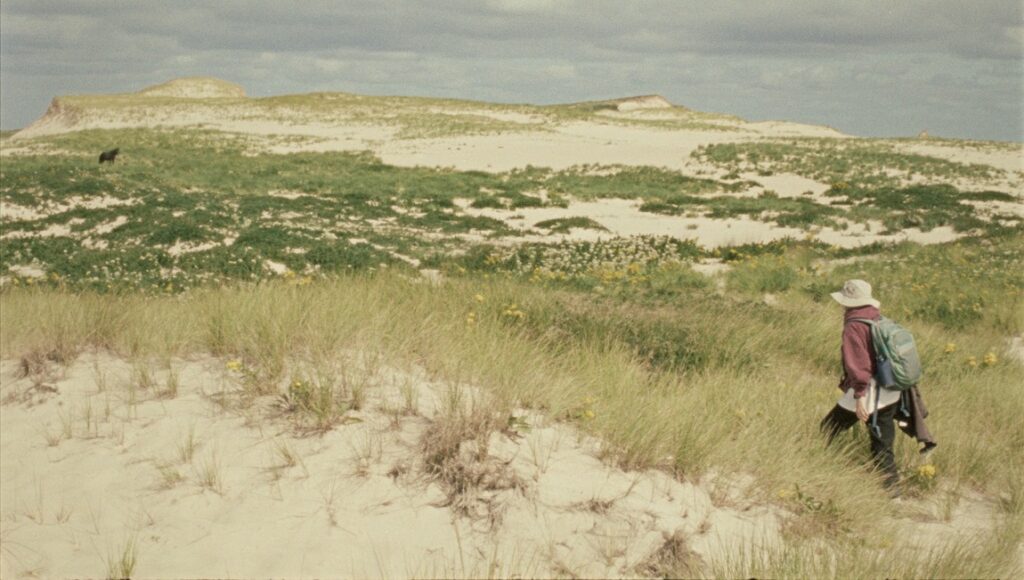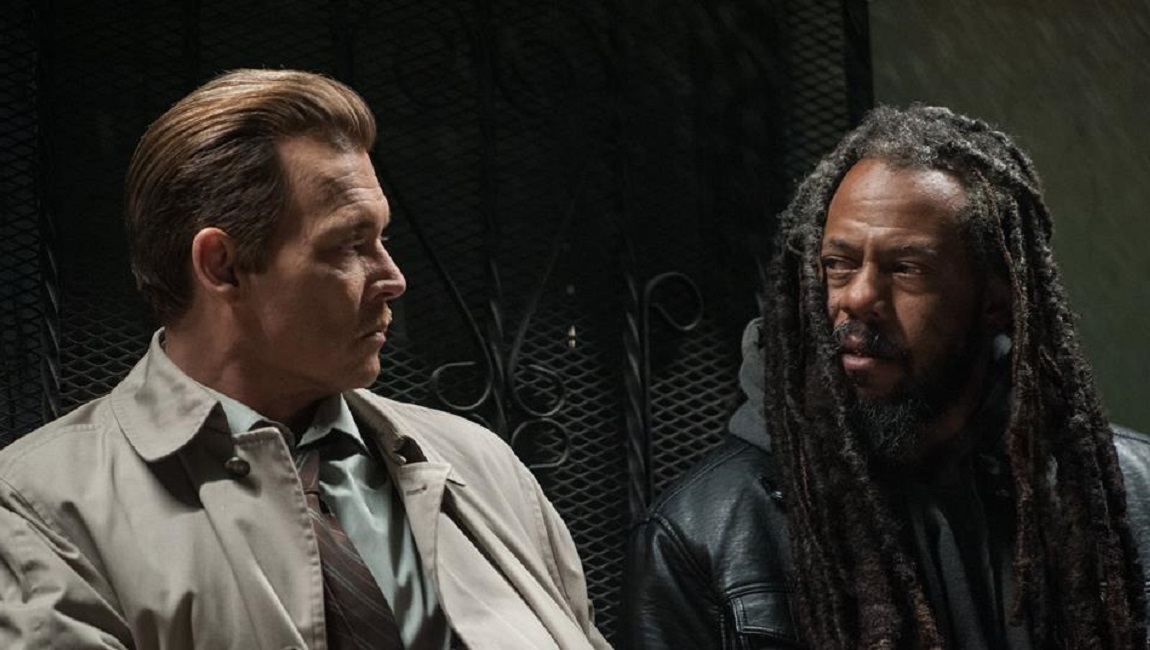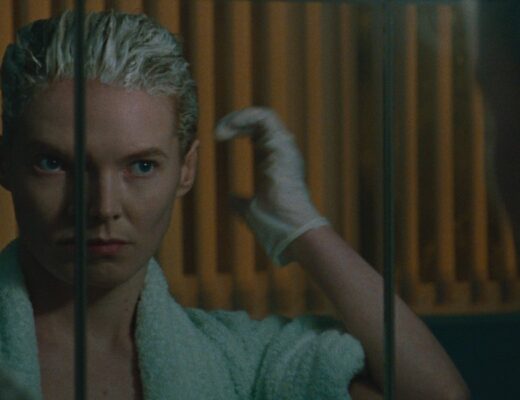Rimini
The curtain doesn’t quite fall in wintry Rimini, this latest nondescript and non-place in life’s long march toward certain death. In Ulrich Seidl’s latest feature, the titular city serves as a liminal space of paradox, between sorrow and amnesia, its damp horizons both unmoored from identity and burdened with the weight of the unresolved past. Set off the Adriatic coast in northern Italy, and suspended in its seemingly eternal blizzard, Rimini tracks the has-been figure of Richie Bravo (Michael Thomas), a pop-star of rock and ballads now primed past middle age, sporting mass, alcoholism, and cynical ennui. More rivetingly, the film calls into question his “has-been” status: returning, for a brief reunion, to Austria to lay their dead mother to rest, Richie and his brother reminisce over wine and the old days, recall their infirm father briefly from his care home, and retread their separate roads once more. But was Richie Bravo ever? His claim to fame — a house filled with memorabilia, a hermetic obsession with lost love, a lifetime singing in lounges — looks less certain by the minute; his name, the vacuous hot thing of the nineties and noughties, claims even less now, being claimed instead by a mysterious woman who calls herself his estranged daughter.
Seidl’s trenchant portrait of a tragic figure celebrates its own unflinching gaze, courtesy of a director whose societal vivisections come with chilling precision and calculated misanthropy. Shot with documentarian veneer, Rimini intrudes upon Richie’s daily movements, gradually disclosing and simultaneously obscuring their purposefulness. He visits several women for sex, but their relationships with him are fraught with the unspoken; they pay him after the deed, and yet it is in Richie where desperation most distressingly shines through. When his daughter demands money as compensation for years of neglect and destitution, his haphazard reaction — first denial, then despondency — says it all of a man lost to loneliness and pitiful bravado: crooning maudlin tunes for the temporary, nocturnal pockets of tourists (have some of them become permanent?); trudging through empty foyers and ghost towns; haggling over small dough while leasing out souvenirs of a younger self to those as fanatic about him as he is; and mired in agonizing stasis, awaiting the improbable coming of spring.
Arguably, all this is trademark Seidl: a tad too clinical, a pinch too predictable at times, given that the absence of further backstory — hinted at with Richie’s brief encounter with his brother Ewald (Georg Friedrich), and likely to be explored in an upcoming companion film, Sparta — frustrates attempts to elevate Rimini from caricature. Especially so for the filmmaker’s acolytes, who might reject its mellowed, almost adulterated causticness, but also a concern for his neophytes, more susceptible to habitual pigeonholing within a larger corpus of Austrian miserabilism. This caricature, nonetheless, possesses a frigid sociological potency whose disparate elements capture a stratified generation’s cultural and libidinal imaginary, typically white, male, middle-class, and anchored to little beyond the bygone echoes of social eminence and utopian intimacy. Seidl’s unspooling of these discomfiting taboos remains acute, though it’s not simply tethered to the viewer’s abject sense of schadenfreude. Instead, a sobering, existential realization is reached through Rimini’s mirthless lens, of the everyman’s winter as a negation and bleak mirror of his lust for life, once vivaciously lived.
Writer: Morris Yang
Happer’s Comet
While technically a “Covid film,” shot on weekends with friends and family during the first wave of lockdowns in early 2020, Tyler Taormina’s Happer’s Comet doesn’t have any designs on grand, how we live now statements. Instead, the technical and logistical issues of making a movie during a pandemic have seemingly seeped into the aesthetic of the actual object itself. Transporting the moody, elliptical storytelling of his first feature, Ham on Rye, onto an even more sparse canvas, Taormina conjures a somnambulist journey through a single night in a nondescript suburban enclave. Everyone here is isolated, every space eerily liminal, until quiet moments of tender connectedness, at last, coalesce in the film’s final moments.
That being the operating mode, there’s virtually no story here to synopsize, as Taormina instead scribbles a series of potential narrative threads around the film’s margins through cryptic, privileged moments. The opening credits play over an extreme close-up of a rotting ear of corn; the camera then begins languidly panning across dark living rooms, empty foyers, and basements, rendering these familiar, lived-in spaces almost alien. A young man furtively applies makeup while alone in his bedroom, while an older man preens in front of a mirror, obviously still proud of his aged physique. An elderly woman nods off in her kitchen, while another shot follows a family dog as it traipses around the house. There are no establishing shots, no recognition of when we are leaving one home and entering another. It is instead a sort of mosaic, occasionally interrupted by recurring shots of a police cruiser prowling the streets with its spotlight on, the bright light source beaming into homes through half-closed blinds. Another scene finds a man trying not to fall asleep behind the wheel of his car; the automobile drifting toward a median creates an immediate tension, a fissure in the otherwise calm mood.
There’s a casual surrealism to the endeavor, perhaps not a surprise to anyone who saw Ham on Rye, with its strange central conceit. Gradually, a number of people begin putting on rollerblades and quietly exiting their homes, as if drawn to some unknown beacon. Indeed, this is a film of apparitions, the mundane suburban milieu rendered otherworldly and ghostly. It’s all the more lovely, then, when Taormina ends his film with a series of embraces, various couples enmeshed in a cornfield and each other’s bodies. Here, finally, is a concrete, tactile recognition of human interconnectedness. Like a mysterious dream that begins to dissipate upon waking, Happer’s Comet feels like stumbling around and blindly reaching out in the dark, and the sweet waves of relief at finding someone still next to you. It’s a deeply beautiful piece of work.
Writer: Daniel Gorman
Queens of the Qing Dynasty
Ashley McKenzie’s debut feature, Werewolf, already suggested a talent to watch in its refracted take on the addiction/relationship drama. While its dramatic sense felt stuck in rote beats, the formal sense was considerably more invigorating, with an extensive use of handheld to isolate body parts and constantly suggest a sense of the outside world’s pressure on two lovers. With her second feature, Queens of the Qing Dynasty, McKenzie has both developed and totally altered her aesthetic to form something considerably more focused and transfixing. Running 40 minutes longer than its predecessor, Queens of the Qing Dynasty operates upon a slightly more complex plot. Another two-hander, it principally follows Star (Sarah Walker), a young woman on the cusp of 19 with mental illnesses, including bipolar disorder and ADHD. On one of her semi-common attempted-suicide hospitalizations, she comes into contact with a queer Chinese immigrant caretaker (Zheng Ziyin) — credited as An, though at one point in their texts Star refers to them as Anne, and in general their conception of their gender remains compellingly ambiguous.
Apart from a clear bisection, with the first half taking place almost exclusively inside the hospital and the second floating in between various temporary residences for Star, including a mental hospital, Queens of the Qing Dynasty operates within a slippery, amorphous structure, continually building a captivating portrait of these two outsiders. An specifically likens their status as a queer immigrant — and as perhaps a “woman in a man’s body” — to Star’s fraught existence, recently orphaned and unable to live on her own. In this context, the eponymous queens are presented by McKenzie in a knowingly Orientalist fashion, as an unreachable ideal for An, who longs to be one of the imperial concubines who didn’t have to do any work but could wield immense power with their feminine wiles. This desire cuts both ways; An’s long and perfectly polished fingernails and consciously exotic presentation in certain moments dovetails with Star’s recurring fantasies of herself in ancient dress with gold talons. It’s fair to say that Queens of the Qing Dynasty (made by a White filmmaker) exists both within and outside of the Chinese-Canadian culture it glancingly tries to depict; Star ultimately remains the viewpoint character, but several scenes conducted in Mandarin with An and their female friends retain a deliciously catty and genuine feeling, altering the balance and lending further nuance to an already shape-shifting film.
Aside from the aforementioned fantasies and other aesthetic breaks — like an exquisite VR reverie, recurring use of crude animation, an apparently unsimulated endoscope scene, and a moment of strobing colors closely attuned to Star’s shifting attention — Queens of the Qing Dynasty trades in Werewolf’s handheld for extraordinarily controlled extreme close-ups, typically in shallow focus, which sharpen the viewer’s attention to minute details. Particular attention is paid to Walker’s eyes and her pupils, which seem to constantly expand and contract in a way that perfectly suits the somewhat unnerving yet largely intimate tone that McKenzie strikes. The ending, with its embrace of the ambiguous, odd relationship that the two develop over a brief period of time, includes a scene in a Chinese restaurant that eventually unfolds over a series of totally disjunctive jump cuts, placing both Star and An in the same place in front of an arch. This simultaneous melding and differentiation of bodies and personalities epitomizes Queens of the Qing Dynasty, a work drenched in eerie, morphing explorations.
Writer: Ryan Swen
Geographies of Solitude
Sable Island, the crescent-shaped sandbar located in the North Atlantic Ocean, is the site of Jacquelyn Mills’ debut feature film Geographies of Solitude. It’s an isolated area, nearly 200 miles southeast of Nova Scotia, and the film’s title hints at the quietude that defines its 12 square miles of land. Such stillness is a result of the small human population: Except for those in archival footage, the only people we see are Mills and Zoe Lucas, a naturalist who has conducted research on the island for more than four decades. She’s a genial, dedicated person, the kind that researchers need to be to live such purposeful lives. While watching Geographies of Solitude, one remembers the truth underlining all great people in science: In their unceasing and underappreciated work, they will never be celebrities. Geographies of Solitude is lovely because it doesn’t try to elevate Lucas to such superstar status; instead, we witness her simply going about day-to-day operations, showcasing the joy therein.
Initially, Lucas came to Sable Island because of its famed horses, but she felt an extreme desire to come back. She found a path to do this through volunteering as a cook, which led her to working alongside researchers. “It’s so compelling to be in a place where you’re learning things directly rather than reading about it in a book,” she says. It’s this enthusiasm for hands-on discovery that is crucial to Geographies of Solitude’s ethos. In periodic flashes of avant-garde filmmaking, Mills uses materials from the island itself to present dazzling lights and colors. She incorporates horsehair and sand, develops film in yarrow and seaweed, and uses contact microphones to capture the sound of specific organisms. These moments are less evocative for the images and audio themselves than what they telegraph: Mills is marrying her passion with Lucas’s, engaging in her own analogous research, but also deepening their relationship in the process. For a film that is subtly underlined by the innate loneliness of Lucas’ life, the act proves notably heartwarming.
For the most part, though, Geographies of Solitude is a straight-ahead documentary. Mills presents striking images of both landscapes and animals, with the graceful swaying of marram grass cutting to the resplendence of horses’ manes. Alongside such lovely wide shots are those in close-up: Lucas writing her findings in a notebook, the endless scrolling of data-filled spreadsheets, the careful handling of dead animal bodies. This juxtaposition of intimate research with grandiose spectacle highlights the feedback loop that is Lucas’s life: The obvious allure of this place led to this commitment to research, and it’s only in doing such work that more beauty is revealed. One testament to her neverending discoveries is how, after deciding to keep track of the island’s invertebrates, Lucas herself identified more than 70 new species.
Much of Geographies of Solitude’ second half, however, points to less enthralling encounters: Specifically, the huge amount of pollution that arrives on the island. At one point, Lucas reveals that 72 percent of the 300 bird corpses she’s found had stomachs filled with plastic. There’s also an incredibly large number of balloons that land on Sable, including one that came all the way from Indiana. Mills is smart to not just make this a clobbering of didactic moralizing though, as this problem is always coupled with Lucas’ solitary life; it’s only here, away from the rest of the world and in the distinct absence of other people, that one can really understand the grand ramifications of littering. There’s a hopelessness to it all, and as the film winds down, Geographies of Solitude moves into necessarily personal territories. “I lost track of everything else,” she confesses. “It appears that my life is Sable Island. That’s all I have, that’s all I do.” There’s a tinge of sadness and regret, but as the film concludes with her talking about the circle of life, there’s contentment in knowing she’s merely part of a greater ecosystem. She’s lived a full life and has done her part, certainly more than most, and she understands that one’s life can only ever be just that.
Writer: Joshua Minsoo Kim
The Kegelstatt Trio
Despite being active since 1990 and directing a dozen or so films of various lengths and in various formats, it wasn’t until around the release of A Woman’s Revenge in 2012, a distinctive costume (melo)drama, that the singular Portuguese cinéaste Rita Azevedo Gomes gained a larger reputation within international film circuits outside her motherland. Her most recent film, The Kegelstatt Trio (originally titled, O trio em mi bemol), premiered at this year’s Berlinale Forum section, and sees Gomes adapting late French filmmaker Éric Rohmer’s 1987 same-name stage play (which itself was inspired by a famous Mozart piece) for the screen. A highly articulated and refined artistic work which is mostly presented in what’s become discernibly Gomes’ style — particularly in those qualities previously seen in 2016’s Correspondences and 2019’s Danses Macabres, Skeletons, and Other Fantasies: a modern-day work of cinematic introspection, scaled to chamber piece status, that revolves around a small group of people in an almost reclusive location far from the hubbub and burdens of the everyday outside world (which couldn’t be more suitable for a work filmed in a hermetic situation during the pandemic). Set at a well-lit, minimalist but snazzy villa in a northern coastal Portuguese town, The Kegelstatt Trio consists mostly of a series of encounters and conversations between a former couple, Paul (Pierre Léon) and Adélia (Rita Durão), who through their dialogues discuss and reflect upon familiar notions of love, passion, and relationships while also trading more highbrow discourse about things like music and art.
While Gomes remains faithful to Rohmer’s seven tableaux structure, she still treats her work with a sui generis method as a meta-film — or more precisely, as a film-in-making. Casting the Spanish veteran and maverick filmmaker Adolfo Arrieta as her counterpart on screen, something of a Rohmer doppelgänger and a godhead figure in front of the camera, it’s fair to say that Gomes in this way forms another trio, alongside the one which already involves Mozart, Rohmer, and herself. In fact, it’s not hard to glean many other trios in the film: one of spaces, bodies, and texts; of language, speech and music; of music, theater and cinema; and one of on-screen rehearsals, improvisations, and a tautly pre-conceived execution. And in depicting them all, Gomes, as she has before, relies upon a very delicate balance working with both mise-en-scène (in terms of different modes of staging, arranging, and blocking of bodies on the set) and mise-en-plans (more or less in the same sense that French film analyst Raymond Bellour has explicated: forming the visual compositions according to the photographic and painterly coordinates of single frames) via dominating medium-long shots.
Thus, despite its predominantly sophisticated conversations and its intellectual nature, Gomes knows perfectly how to control the overall atmosphere of her film through a very free-flowing rhythm, a subtle comic tone, a blithe mood, and, perhaps foremost, a colorful range of vocal accentuations, intonations, and pulsations of her actors’ rhetoric, without coming off as either snobbish or tedious. It’s also notable how Gomes presents all this as some holy mix of the Straubs, João César Monteiro, and (again) Rohmer, crafting her own version of what can be easily read as a peculiar, nonconformist rom-com. To this end, and as an allusion to Mozart’s piece, Gomes masterfully (and seemingly, effortlessly) proceeds to delineate both the harmonies, counterpoints, and dissonances of a contemporary relationship, ultimately, forming a resonant, euphonious (re)union between the man and the woman. And as much as Paul represents the intellectual aspects of a man of curated taste in his persistent appreciation of high-cultured art and classical music, Adélia remains curiously open to the more sensual and unfamiliar dimensions of life. For Paul, essence lies within a sense of corporeal stasis but intellectual devotion, while Adélia conversely praises the importance of bodily movement. It’s reflects a synthesis that vividly defines Rita Azevedo Gomes’ contemplative and sensorial The Kegelstatt Trio — meticulously studying shifting bodily gestures, postures, and movements within fixed compositional shots, architectural spaces and natural landscapes. That leaves us with the last, but definitely not the least, of the film’s trios, one at risk of feeling gauche but which Gomes executes with delicacy and aplomb: it’s nothing less than the trinity of mind, body and soul.
Writer: Ayeen Forootan

